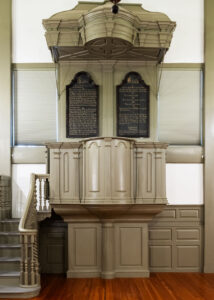One of the Finest Colonial Interiors in Rhode Island
BUILT: 1730
BARNEY STREET

Seventh Day Baptist Meeting House, ca. 1890s
The Seventh Day Baptist Meeting House was constructed in 1730 by Richard Munday on Barney Street, and can now be seen as part of the Newport Historical Society’s building.

Seventh Day Baptist Meeting House pulpit. Photo by Shannon Hammond.
The first Baptist church in Newport was founded in 1644 by John Clarke. Several years later, a group of 7th Day Baptists (celebrating the Sabbath on Saturday) separated from Clarke’s church. In its early years this congregation met in a building at Green End, but as the congregation grew land on Barney Street was purchased for the purpose of building a new church. The building was erected in 1730 and was considered to be one of the finest colonial interiors in Rhode Island. The ceiling is vaulted and composed of curved oak tie beams. The walls are made of carved paneling; the unusual pulpit is wine glass-shaped and similar to the one in nearby Trinity Church. The balusters on the stairs leading to the pulpit exhibit exquisitely detailed woodcarving. The congregation was always diverse; African-Americans occupied pews in the east gallery and Native Americans are listed in the church records. After the Revolution, however, many members of the congregation moved away and services were abandoned at the church in the mid-19th century. During the Civil War, the church was used by the Shiloh Baptist congregation, which was primarily African-American.
Restoration

Seventh Day Baptist Meeting House balcony during restoration.
The grand reopening of the newly-restored Seventh Day Baptist Meeting House (Leatherman Program Center) was celebrated the summer of 2009, in conjunction with a rare clothing exhibit, From Homespun to High Fashion.
This restoration project was funded by grants from the van Beuren Charitable Foundation, the Rhode Island Historical Preservation & Heritage Commission, and the Seventh Day Baptist Historical Society.
Rent the Seventh Day Baptist Meeting House for your next event.